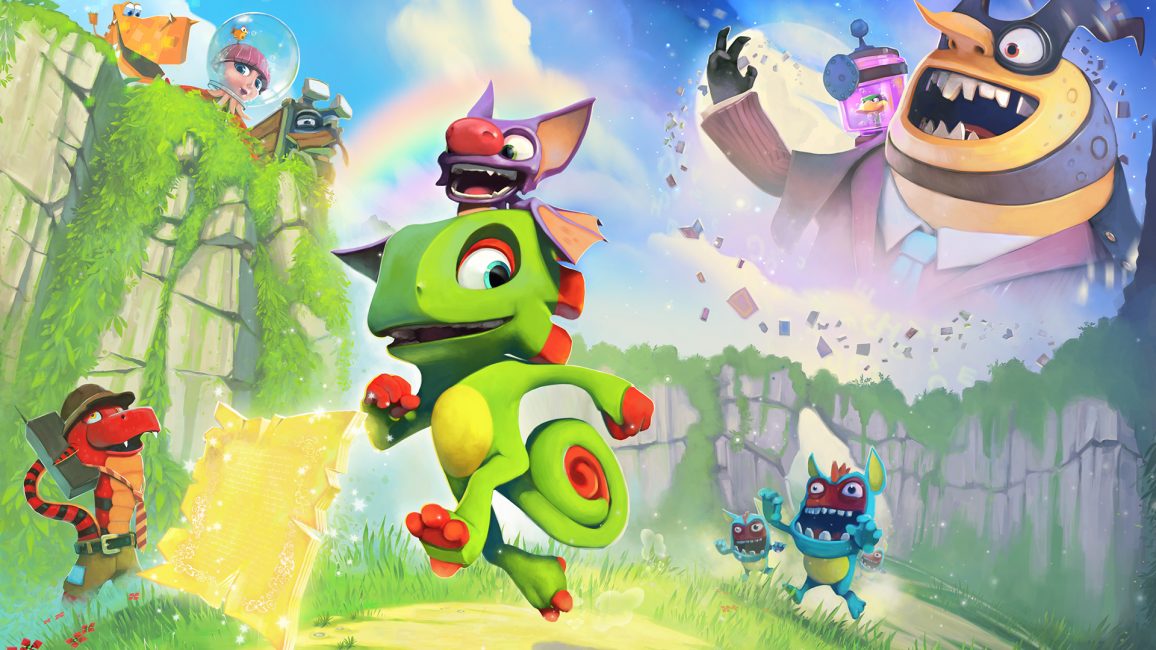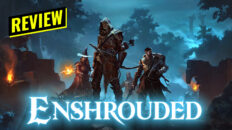Developer: Playtonic Games
Publisher: Team 17
Reviewed on: PC
Code Received.
Yooka-Laylee hangs its hat on the legacy created by Banjo-Kazooie. These games are characterized by wacky humor, quirky characters, cartoony graphics, challenging platforming, and copious collectibles. All the elements that made early 3D platformers fashionable are present and accounted for in Yooka-Laylee, even some of the frustrating bits. It’s in the areas where Yooka-Laylee deviates from the formula that makes this dynamic duo somewhat dubious.
The game introduces you to Yooka (the green chameleon), and Laylee (the purple bat), sun-bathing outside of their boat-house as their special golden book suddenly gets sucked away, the pages drifting all over the world. It turns out that the evil Capitol B, a bumbling megalomaniac, has decided to steal all of the world’s books so he can corner the market and be the only salesman around. This doesn’t sit well with Yooka and Laylee, so they decide to venture off to recover their book, which also happens to be the key to stopping Capitol B.

“Instead of many small worlds like in Banjo-Kazooie, Yooka-Laylee has only a handful of worlds that can be expanded once you collect enough Pagies.”
The story is a fairly simple excuse to send you through several worlds on an adventure to collect dozens of pages called “Pagies” and rebuild the golden book. The Pagies work exactly like the puzzle pieces in Banjo-Kazooie. You must navigate obstacles, help characters, and solve puzzles to collect them within each world, then use them to unlock new worlds. The big difference here is that instead of many small worlds like in Banjo-Kazooie, Yooka-Laylee has only a handful of worlds that can be expanded once you collect enough Pagies. Ultimately, it’s your decision to expand existing levels or jump into an entirely new world.
You should always have enough Pagies to unlock whatever you want as long as you take the time to fully explore each world. Even the hub world, Hivory Towers, has Pagies to find.
Hivory Towers actually serves as a fully explorable level, as well as a hub that lets you access the different worlds. It can be challenging to navigate the Towers as passageways are often hidden or out of reach if you haven’t unlocked the required skill to access them. In fact, I found myself spending more time than I would have liked wandering around the corridors of Hivory Towers searching for the next world or skill to unlock. While it’s certainly an interesting way to handle a hub world, it also felt like it was unnecessarily prohibitive, preventing me from playing the game at my own pace.

The worlds in Yooka-Laylee are varied and expansive. Each one has a unique aesthetic from rainforest ruins, to frozen caves, and even a Halloween-themed creepy swamp. They house a variety of challenges that test your platforming, puzzle solving, and navigation skills. While each one has a unique set of challenges, there are also recurring ones such as a (literarily) on-rails mine cart obstacle course, “Ghost Writers” to find and collect, and Quills to search for.

The Quills you collect allow you to purchase skills from Trowser, the snake salesman. You’ll find Trowser randomly throughout Hivory Towers and in each world. You can exchange Quills for an ever-expanding arsenal of new moves like the ability to shoot pellets, spring-jump to high ledges, and glide using Laylee’s wings. It’s your call which skills you purchase at any given time, however, there are some skills that are absolutely required to make progress.
While there are instances where Trowser will show up to give you a game-critical move for free, there are other times where he remains elusive and the game doesn’t convey precisely what you need to do in order to proceed. This would have been alleviated if skills unlocked at set intervals, or you began the game with all the critical moves you needed to, at the very least, access the entrance to every world in the game.
In fact, the free-form exploration element of Yooka-Laylee is one the most frustrating things about it. By trying to make the game more open it loses the tightly-focused, hand-crafted feel of the original Banjo-Kazooie. This leads to wandering around the game’s levels, that are dotted with respawning nuisance enemies, and looking for that one thing you may have missed. With no map, the huge sprawling worlds can also become overwhelming with questions like “Have I been in this cave before?” and “Where was that place again?”
For the most part, Yooka-Laylee plays well, riding the line between old and new. The moves list doesn’t contain too many surprises, but everything generally feels good to execute. Yooka can swing Laylee around to knock enemies back, and Laylee can lift Yooka up into the air and then smash him down to the ground to cause area damage or activate buttons. It’s a fairly typical move set, one that’s been standard in games like this for almost two decades.
Yooka-Laylee does have some new tricks, however. For instance, Yooka can eat fruits that give him elemental abilities. Fire fruits let him breath fire and withstand high heat, while icey fruits allow him to shoot ice pellets. The shooting is imprecise and I found myself “spraying and praying” more often than not, but the different fruits do add variety to the puzzles and combat encounters.
There are a few instances here and there where the camera and controls don’t always play nice. The camera is very aggressive when it comes to avoiding level geometry, and this can lead to moments where you’ll have to fight with the camera in order to get it where you want. Also, there are gameplay segments that straddle the line between challenging and unnecessarily frustrating. A slippery truck driving sequence and a dimly lit cave come to mind. They stand out mostly because they feel intentionally punishing, unlike the rest of the challenges in the game.

I have to make sure I mention the fact that the game, while sometimes poking fun at the genre’s platitudes, also relies on some of their worst bits. Many will remember a particularly obtuse quiz section near the end of Banjo-Kazooie that required you to recall obscure details about the game’s various levels and characters. I was bewildered to learn that Yooka-Laylee uses a similar quiz-style mini-game to gate your progress at several intervals. At first I thought it was going to be a tongue-in-cheek joke, asking you simple questions and making fun of the concept, however, it goes further than that. While the questions aren’t as arbitrary as they were in Banjo-Kazooie, they do ask for weirdly specific information that may be difficult to recall on the spot. These sequences were, by far, the worst moments of my playthrough.
“The bouncy, upbeat tempo perfectly underscores the whimsical, wacky worlds you explore and characters you meet.”
Where Yooka-Laylee feels most like the games it pulls from, is in its audio-visual presentation, which is executed exceptionally well. The cartoony characters look fantastic with sharp, high-resolution models and the environments look like they could have been pulled straight out of Banjo-Kazooie. The game also runs flawlessly, maintaining a solid framerate throughout.
But the real star here is the soundtrack. The original composer for Banjo-Kazooie has returned to score Yooka-Laylee, and this is by far the most immersive part of the game. The bouncy, upbeat tempo perfectly underscores the whimsical, wacky worlds you explore and characters you meet. It’s another piece of the puzzle that truly works in the game’s favor. It’s also a rare soundtrack that stands wholly on it’s own, independently from the context of the game.
There’s also a suite of local multiplayer mini-games that are nothing, if functional. Most of them can be played with up to four players and run the gamut from kart racing, to a side-scrolling “Flappy Bird” clone. They can also be played solo, but they’re clearly designed for some couch co-op shenanigans. There’s nothing groundbreaking here, but it’s a nice addition for people looking to get the whole family involved.

Yooka-Laylee is an interesting package. It was built on the promise of bringing new and old gamers a taste of a specific type of game that’s mostly been forgotten. By pulling talent from Rare, the pitch was simple: “Make a new Banjo-Kazooie” and while most of the pieces line up, there are a few rough edges that make for a somewhat mixed package.
As a stand-alone product, Yooka-Laylee is a fantastic game and a landmark achievement for independent games and the crowdfunding business model. However, in the context of what it sets out do it, it falls a little short. Recapturing the magic of old while also modernizing many of the mechanics for a more contemporary audience is no small feet. And while Yooka-Laylee stumbles here and there, it’s still a great revival of a formula that hasn’t been seen in many years, and something that everyone should experience, regardless of age.
[full_width]PC Specs:
Windows 10 Pro 64-bit
Intel Core i7-4790K 4.0GHz
16GB RAM
GeForce GTX 980 Ti 6GB VRAM
Samsung EVO 850 SSD[/full_width]








